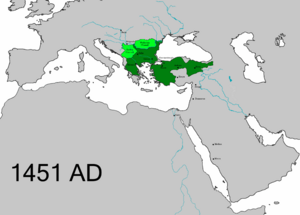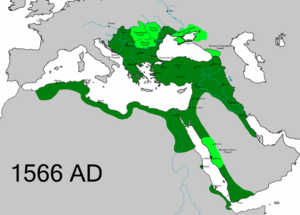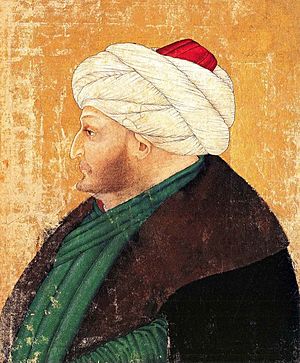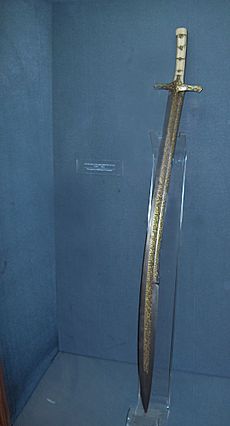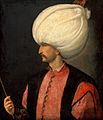Classical Age of the Ottoman Empire facts for kids
The Classical Age of the Ottoman Empire (called Klasik Çağ in Turkish) was a special time in the history of the Ottoman Empire. It started in 1453 with the conquest of Constantinople and lasted until the late 1500s, around the end of Suleiman the Magnificent's rule (1520–1566). During this period, the sultan had incredible power, and the empire set up many of its important systems. The Ottoman Empire grew much larger, leading to a time of peace and order that some historians call the Pax Ottomana (Ottoman Peace).
Contents
Growing the Empire's Land
The Ottoman Empire grew a lot during its Classical Age. It began with Mehmed II (who ruled from 1451 to 1481) capturing Constantinople in 1453. Mehmed II then made the empire stronger in the Balkans and Anatolia. He conquered Serbia (1454–5), the Peloponnese (1458–9), Trebizond (1461), and Bosnia (1463). Many Venetian lands in Greece were also taken during a war from 1463 to 1479. By 1474, the Ottomans had defeated their rival, the Karamanids, in Anatolia. In 1475, they took Kaffa on the Crimean Peninsula, making the Crimean Khanate a state that answered to them. In 1480, they even tried to invade Otranto in Italy, but Mehmed II's death stopped this plan.
The rule of Bayezid II (1481–1512) was a time of making the empire stronger after all the fast conquests. The empire's land grew only a little. In 1484, Bayezid attacked Moldavia, making it a vassal state and taking important ports. Major Venetian ports in Greece and Albania were captured during a war from 1499 to 1503. However, by the end of his rule, the new Safavid Empire in the east started to threaten Ottoman lands.
Fast growth began again under Selim I (1512–1520). He defeated the Safavids in the Battle of Chaldiran in 1514. This added much of eastern Anatolia to the empire. In 1516, he fought against the Mamluk Sultanate, taking Syria and then Egypt the next year. This was a huge change for the Ottoman Empire. It now ruled over important Muslim lands in the Middle East and protected the holy cities of Mecca and Medina. This made Islamic ways more important in the government and brought the Arabic-speaking world closer to the Ottoman heartlands. Under Selim, the empire grew from about 341,100 square miles to 576,900 square miles.
Expansion continued during the first part of Suleiman I's rule (1520–1566). He first conquered Belgrade (1521) and Rhodes. Then, he invaded Hungary in 1526, defeating and killing King Louis II of Hungary in the Battle of Mohács. He briefly took Buda. Hungary then had a civil war, and the Ottomans supported John Zápolya as a vassal prince. When their rivals, the Habsburgs, started winning, Suleiman stepped in. He conquered Buda again and added it to the empire in 1541. Suleiman also led big campaigns against Safavid Iran, capturing Baghdad in 1534 and adding Iraq. Ottoman rule also spread to much of North Africa, and they took coastal Yemen in 1538.
After taking Buda in 1541, the empire's growth slowed down. The Ottomans focused on making their huge gains stronger and fought wars on three fronts: in Hungary, in Iran, and in the Mediterranean Sea. New conquests were small and helped secure the empire's position. Ottoman control over Hungary grew, and a second Hungarian province was set up in 1552. Control over North Africa increased with the capture of Tripoli in 1551. The Ottomans also made their position stronger in the Red Sea by taking Massawa (1557) and extending their rule over much of coastal Eritrea and Djibouti. By the end of Suleiman's rule, the empire was about 5,000,000 square kilometers large.
Important Rulers and Events
Mehmed II (1451–1481)
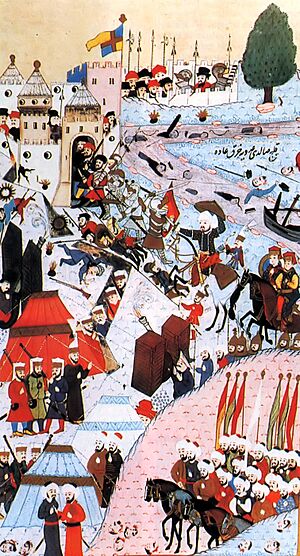
After conquering Constantinople, Mehmed II focused on Anatolia. He wanted to unite the different Turkish states there, called Beyliks, and the Greek Empire of Trebizond. He also made friends with the Crimean Khanate. Mehmed II defeated the White Sheep Turcomans in 1473, who were a threat because they were allied with Christian powers.
Mehmed also conquered the Despotate of Morea in 1460 and the Empire of Trebizond in 1461. These were the last parts of the old Byzantine Empire. Taking Constantinople brought great fame to the Ottoman Empire.
Mehmed II moved into Eastern Europe, trying to conquer Belgrade in 1456. Hungarian commanders successfully defended the city, and the Ottomans lost many soldiers. However, the Ottomans did eventually take almost all of Serbia.
In 1463, Mehmed invaded and quickly conquered Bosnia, executing its last king.
In 1462, Mehmed II had a conflict with Prince Vlad III Dracula of Wallachia. Vlad attacked Ottoman forces and caused many losses. Mehmed II launched a big attack against Vlad, but Vlad's surprise night attack caused many Ottoman casualties. Mehmed II had to retreat. He left Vlad's brother, Radu, to take control of Wallachia.
In 1475, the Ottomans lost a big battle to Stephen the Great of Moldavia. In 1476, Mehmed won a costly victory against Stephen. He tried to capture Moldavia's capital but couldn't. With sickness and little food, Mehmed had to retreat.
Skanderbeg, an Albanian noble, led a rebellion against the Ottomans. He united Albanian groups in 1444. Mehmed II tried twice to conquer Albania while Skanderbeg was alive but failed. Albanians won many battles against the Ottomans during this time. After Skanderbeg died in 1468, the Ottomans finally conquered Albania in 1478. Mehmed II also personally led a difficult Siege of Shkodra in 1478–79.
Mehmed II invaded Italy in 1480, hoping to capture Rome. He quickly took Otranto in 1480. But after Mehmed's death in 1481, Papal forces took Otranto back. His son, Bayezid II, became the next sultan.
Bayezid II (1481–1512)
When Bayezid II became sultan, he first had to fight his younger brother, Cem Sultan. Cem claimed to be the Sultan of Anatolia but was defeated and fled.
Sultan Bayezid attacked Venice in 1499. A peace treaty was signed in 1503, and the Ottomans gained the last Venetian strongholds in the Peloponnesos and some towns along the Adriatic coast. In the early 1500s, the Mamluks and Persians under Shah Ismail I formed an alliance against the Ottomans. The war ended in 1511, with the Ottomans winning.
Later, Bayezid's son Ahmet tried to force his father to make him ruler. His brother Selim had to flee. When Ahmet was about to be crowned, the Janissaries (elite Ottoman soldiers) stopped him. They killed Ahmet and forced Bayezid to call Selim back and make him sultan. Bayezid gave up his throne and died soon after.
Selim I (1512–1520)
During his rule, Selim I (also called Yavuz, meaning "the Grim") greatly expanded the empire's borders to the south and east. Around 1512, the Ottoman navy grew strong under his command. This allowed the Ottomans to challenge Venice, a major sea power. At the Battle of Chaldiran in 1514, Ottoman forces under Selim I won a big victory against the Safavids. This made the eastern border safe and led to the conquest of eastern Anatolia and northern Iraq. He also defeated the Mamluk Sultanate and conquered most of Syria and Egypt, including Jerusalem and Cairo.
Suleiman the Magnificent (1520–1566)
Suleiman the Magnificent first stopped a revolt in Damascus. By August 1521, Suleiman had captured Belgrade from Hungarian control. In 1522, Suleiman captured Rhodes. On August 29, 1526, Suleiman defeated Louis II of Hungary at the Battle of Mohács. In 1541, Suleiman added most of present-day Hungary to the empire. He also set up Zápolya's family as rulers of the independent principality of Transylvania, which was a state that answered to the empire.
The Shi'ite Safavid Empire ruled Persia and modern-day Iraq. Suleiman fought three campaigns against the Safavids. In the first, the important city of Baghdad fell to Suleiman's forces in 1534. The second campaign (1548–1549) led to Ottoman gains in Tabriz and Azerbaijan. The third campaign (1554–55) was a response to Safavid attacks. The two empires eventually signed the Peace of Amasya. This peace treaty ended fighting for 20 years.
Huge areas of North Africa were added to the empire. The Barbary States of Tripolitania, Tunisia, and Algeria became provinces. The piracy carried out by the Barbary pirates was part of the wars against Spain. The Ottoman Empire also became very strong at sea in the Mediterranean for a short time.
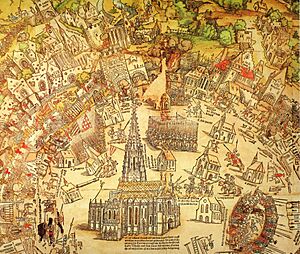
Ottoman navies also controlled the Red Sea. They held the Persian Gulf until 1554, when their ships were defeated by the navy of the Portuguese Empire. In 1533, Khair ad Din, known as Barbarossa, became the main admiral of the Ottoman navies. He fought actively against the Spanish navy.
In 1535, the Habsburg Holy Roman Emperor, Charles V, won a victory against the Ottomans at Tunis. But in 1536, King Francis I of France allied with Suleiman against Charles. In 1538, Charles V's fleet was defeated at the Battle of Preveza by Khair ad Din. This secured the eastern Mediterranean for the Ottomans for 33 years.
Gallery
See also
- Classical Ottoman architecture


